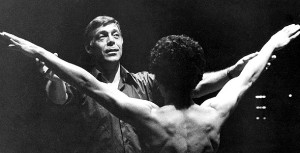 I went to see the Paul Taylor Dance Company (it’s changed its name, but I can’t get used to the new one) at Lincoln Center on Saturday afternoon. Regular readers of this blog may recall what I wrote in this space about seeing the Taylor company last year in Florida. On that occasion I cited an essay about Taylor and his work that I wrote in 1999:
I went to see the Paul Taylor Dance Company (it’s changed its name, but I can’t get used to the new one) at Lincoln Center on Saturday afternoon. Regular readers of this blog may recall what I wrote in this space about seeing the Taylor company last year in Florida. On that occasion I cited an essay about Taylor and his work that I wrote in 1999:
Taylor’s singular achievement as a choreographer has been to siphon the angst out of modern dance without simultaneously removing the seriousness. Even when his subject matter is shocking, his tone invariably remains light and effortless, which is why the heavy emotional weather of his darker dances never becomes oppressive….He has taken modern dance and stood it on its head, lightening its ponderous textures with wit and using comedy (which is tragedy inverted) to illuminate the blackest recesses of the soul.
Not surprisingly, Mrs. T and I have been longing to see the company again ever since then. Saturday’s program, which included Esplanade, Taylor’s 1975 masterpiece, and Orbs, a rarely performed dance from 1966 whose score consists of excerpts from Beethoven’s late string quartets, seemed hard to top, so I booked a pair of seats and crossed my fingers. Alas, Mrs. T was under the weather at the appointed hour, so I brought in her stead Hilary Gardner, a jazz-singing friend who had previously accompanied me to last summer’s Shakespeare in the Park production of The Tempest and found it overwhelming. I had a notion that she would be no less responsive to Esplanade, and I was right.
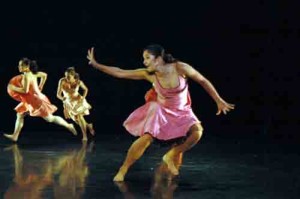 I’ve loved Esplanade, in which Taylor blends walking, running, hopping, sliding, and the music of Bach into a plotless explosion of pure choreographic delight, ever since I first started looking at the dance three decades ago. Arlene Croce called it “a classic of American dance” when she reviewed the first performance in The New Yorker, and her snap judgment has long since passed the test of time. Twenty-five years later, Time asked me to pick the three greatest dances of the twentieth century, and I chose Esplanade, George Balanchine’s The Four Temperaments, and Antony Tudor’s Jardin aux Lilas. Back in my regular dancegoing days, I introduced many of my friends to Taylor’s work by taking them to see it. One of them, Nancy LaMott, couldn’t say a word for a good two minutes after the curtain came down. It was as if all the circuits in her brain had suddenly been fused by an excess of joy.
I’ve loved Esplanade, in which Taylor blends walking, running, hopping, sliding, and the music of Bach into a plotless explosion of pure choreographic delight, ever since I first started looking at the dance three decades ago. Arlene Croce called it “a classic of American dance” when she reviewed the first performance in The New Yorker, and her snap judgment has long since passed the test of time. Twenty-five years later, Time asked me to pick the three greatest dances of the twentieth century, and I chose Esplanade, George Balanchine’s The Four Temperaments, and Antony Tudor’s Jardin aux Lilas. Back in my regular dancegoing days, I introduced many of my friends to Taylor’s work by taking them to see it. One of them, Nancy LaMott, couldn’t say a word for a good two minutes after the curtain came down. It was as if all the circuits in her brain had suddenly been fused by an excess of joy.
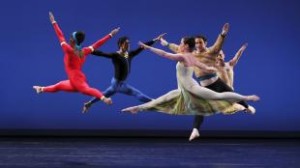 Orbs is a somewhat tougher nut to crack, but only because of its greater length and the more difficult music to which it is set, which includes Beethoven’s Grosse Fuge and the whole of his B Flat Quartet, Op. 130. The dance itself is so immediately accessible that Croce felt moved to describe it as “perhaps the most charming work in the modern dance repertory.” I don’t know whether I’d go that far, but I can’t imagine anyone finding it hard to enjoy. The décor is by Alex Katz, the most deservedly popular of modern painters—Taylor, with whom he collaborated on several occasions, was very much a part of Manhattan’s avant-garde visual-arts scene back in the Sixties—and the “plot,” if you want to call it that, is wonderfully fanciful.
Orbs is a somewhat tougher nut to crack, but only because of its greater length and the more difficult music to which it is set, which includes Beethoven’s Grosse Fuge and the whole of his B Flat Quartet, Op. 130. The dance itself is so immediately accessible that Croce felt moved to describe it as “perhaps the most charming work in the modern dance repertory.” I don’t know whether I’d go that far, but I can’t imagine anyone finding it hard to enjoy. The décor is by Alex Katz, the most deservedly popular of modern painters—Taylor, with whom he collaborated on several occasions, was very much a part of Manhattan’s avant-garde visual-arts scene back in the Sixties—and the “plot,” if you want to call it that, is wonderfully fanciful.
Robert Gottlieb summed it up with his usual deftness when he reviewed the 2011 revival of Orbs in the New York Observer:
Orbs also provided Taylor with one of his greatest roles: His character is the Sun (in a white unitard, decorated with silver stars), and around him revolve the planets and moons. He presents them–the planets in two male-female couples, the moons four ravishing girls in shimmering Alex Katz costumes–and proceeds to instruct, nurture, discipline and cherish them….
When, after the intermission, we find ourselves down to Earth and among mere humans, it’s at an autumn wedding. Everyone’s in brown. The Sun is now the solemn, yet occasionally sly, minister. The bride and her bridesmaids and her conventionally weeping mother are our old friends, the female planets and their moons. We recognize the male planets in the groom, frantic with nerves–obsessively checking his hair, his tie, his fly–and his best man….
And then we’re back in the heavens, for the most beautiful and resonant passage in the entire work–“Plutonian Winter.” The orbs are deadened, life has drawn to a halt….
Paul Taylor may be a pessimist, but he’s not a sadist, at least not here. Winter, too, passes, and he brings the Sun and its satellites back to life and harmony in a reaffirming whirlwind of a coda.
 Part of the charm of Orbs is that these delicious occurrences are accompanied by the most monumentally profound music that Beethoven ever wrote. The incongruity of the juxtaposition is occasionally startling, even jolting, yet you never feel that Taylor is having fun at Beethoven’s expense: he is simply showing you what he hears in the music. In Private Domain, his 1987 autobiography, he remarked that “the two-and-two-thirds of Beethoven’s last quartets that I pick might have been less intimidating had I realized how revered they are.” Take a close look at the unexpected swerve in the middle of that sentence and you’ll come away with a clue to the paradoxical way in which his creative mind works.
Part of the charm of Orbs is that these delicious occurrences are accompanied by the most monumentally profound music that Beethoven ever wrote. The incongruity of the juxtaposition is occasionally startling, even jolting, yet you never feel that Taylor is having fun at Beethoven’s expense: he is simply showing you what he hears in the music. In Private Domain, his 1987 autobiography, he remarked that “the two-and-two-thirds of Beethoven’s last quartets that I pick might have been less intimidating had I realized how revered they are.” Take a close look at the unexpected swerve in the middle of that sentence and you’ll come away with a clue to the paradoxical way in which his creative mind works.
Orbs is rarely revived because of its length, and one of the reasons why I went out of my way to go to Saturday’s program was because it was the only one of Taylor’s major dances that I’d never seen. I was amazed to discover that most of the first half was set to the fearsomely rebarbative Grosse Fuge, and astonished that all of the second half was set to Op. 130, a work that I all but worship. If anyone would have felt inclined to bristle at finding comedy in these supremely sublime pieces, it would have been me. Instead, I wept.
 As Hilary and I left the theater, I remembered something that Taylor once told me when I asked whether he thought his dances would survive him. “I don’t know if they’ll last,” he said. “I try to make them to last. They’re not made to be seen one time.” I suppose I’ve seen Esplanade fifteen or twenty times, never without finding new things at which to marvel. I doubt I’ll be so lucky with Orbs, since it isn’t performed very often and I’m not nearly so young as I was when I first discovered Taylor. It’s quite possible, in fact, that I’ll never see it again, just as I’ll almost certainly never return to the exquisitely beautiful Smoky Mountains waterfall to which my brother directed me nine years ago.
As Hilary and I left the theater, I remembered something that Taylor once told me when I asked whether he thought his dances would survive him. “I don’t know if they’ll last,” he said. “I try to make them to last. They’re not made to be seen one time.” I suppose I’ve seen Esplanade fifteen or twenty times, never without finding new things at which to marvel. I doubt I’ll be so lucky with Orbs, since it isn’t performed very often and I’m not nearly so young as I was when I first discovered Taylor. It’s quite possible, in fact, that I’ll never see it again, just as I’ll almost certainly never return to the exquisitely beautiful Smoky Mountains waterfall to which my brother directed me nine years ago.
Time was when that thought would have reduced me to something like despair. Now I feel more inclined to rejoice that I’ve had the good fortune to see Orbs once. Perhaps I’m coming to understand what Justice Holmes meant when he said that “[l]ife grows more equable as one grows older; not less interesting, but I hope a little more impersonal. An old man ought to be sad. I don’t know whether I shall be when the wind is west and the sky clear.” I hope he was right, just as I hope Robert Browning was right when he wrote:
Youth ended, I shall try
My gain or loss thereby;
Leave the fire ashes, what survives is gold:
And I shall weigh the same,
Give life its praise or blame:
Young, all lay in dispute; I shall know, being old.
Perhaps I shall, too.
* * *
Paul Taylor’s American Modern Dance will be performing at Lincoln Center through Sunday. Orbs will be performed on Thursday and Esplanade on Friday.
The finale of Esplanade, performed by the original cast and originally shown on PBS’ Dance in America in 1978:
The Brentano String Quartet plays the cavatina from Beethoven’s B Flat Quartet, Op. 130, at Princeton in 2012:



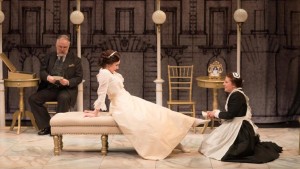 Shaw ranked “Widowers’ Houses” among his “unpleasant” plays, since it deals with the grim subject of urban poverty. But he knew that the only way to get most people to think about unpleasant things is to make them laugh, and so he concocted a fizzy boulevard comedy à la Oscar Wilde whose anti-hero, Sartorius (Terry Layman), is a rich, self-consciously pompous fellow who is looking to marry off Blanche (Talene Monahon), his difficult daughter, to a well-bred gent in need of a fortune. Enter Harry (Jeremy Beck), a doctor from a suitable family that lives on its income. So what’s the problem? Just this: Sartorius is a notorious slumlord who makes his money by “screwing” rent (Shaw’s word) out of the impoverished occupants of the rundown tenements that he owns….
Shaw ranked “Widowers’ Houses” among his “unpleasant” plays, since it deals with the grim subject of urban poverty. But he knew that the only way to get most people to think about unpleasant things is to make them laugh, and so he concocted a fizzy boulevard comedy à la Oscar Wilde whose anti-hero, Sartorius (Terry Layman), is a rich, self-consciously pompous fellow who is looking to marry off Blanche (Talene Monahon), his difficult daughter, to a well-bred gent in need of a fortune. Enter Harry (Jeremy Beck), a doctor from a suitable family that lives on its income. So what’s the problem? Just this: Sartorius is a notorious slumlord who makes his money by “screwing” rent (Shaw’s word) out of the impoverished occupants of the rundown tenements that he owns….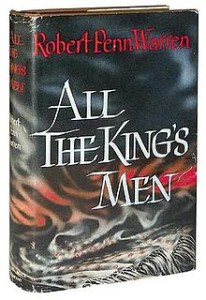 In today’s Wall Street Journal “Sightings” column I take note of the contemporary relevance of Robert Penn Warren’s
In today’s Wall Street Journal “Sightings” column I take note of the contemporary relevance of Robert Penn Warren’s  Is Stark right to be so pessimistic about what he calls “the nature of things”? If so, does that justify his own increasingly monstrous behavior? Or can noble ends be corrupted by the evil means through which we seek to bring them into being? The fact that Warren deliberately leaves this question open is part of what gives “All the King’s Men” its permanent relevance…
Is Stark right to be so pessimistic about what he calls “the nature of things”? If so, does that justify his own increasingly monstrous behavior? Or can noble ends be corrupted by the evil means through which we seek to bring them into being? The fact that Warren deliberately leaves this question open is part of what gives “All the King’s Men” its permanent relevance…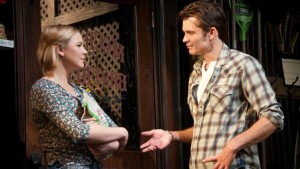 •
•